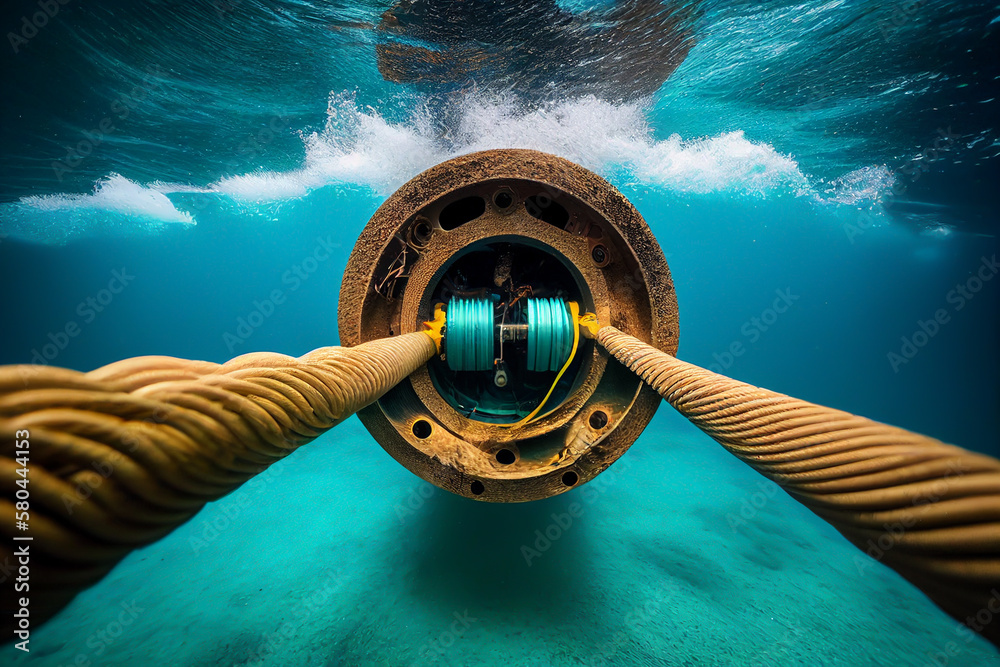Undersea cables are the lifeblood of modern internet connectivity, intertwining nations and facilitating the flow of crucial data across continents. These undersea data cables, often overlooked, are intricate networks of fiber optic cables that send billions of messages and transactions beneath the ocean’s surface. With over 95% of global internet traffic traveling through these submerged conduits, they represent an essential component of our digital infrastructure. The reliability and bandwidth provided by these cables are paramount for everything from simple emails to massive financial transactions, linking users worldwide in an interconnected digital ecosystem. As we increasingly rely on this cable infrastructure, understanding its vulnerabilities reveals just how crucial these unassuming underwater links truly are.
Often termed as underwater telecommunications networks, these hidden conduits are vital for maintaining the global internet. Fiber optic networks that traverse the ocean floors enable rapid data transmission across vast distances, ensuring that our digital communications remain seamless. From facilitating personal connections to powering global businesses, these submerged cables play a pivotal role in sustaining modern life. The intricate system of cable infrastructure supports the operations of countless industries and is crucial for the economic stability of nations. As our reliance on internet services continues to grow, the importance of these underwater fiber optic systems in shaping global connectivity cannot be overstated.
The Vital Role of Undersea Data Cables in Global Connectivity
Undersea cables are the lifeblood of our global internet infrastructure, facilitating more than 95% of international data traffic. These cables, often constructed with advanced fiber optic technology, allow for high-speed internet connectivity that connects continents and underpins nearly every aspect of modern life. From sending emails to streaming movies, our reliance on these cables demonstrates their critical importance in maintaining effective communication and economic transactions across the globe. Without these undersea data cables, many regions would experience severely degraded internet service, leading to significant limitations in both personal and business communication.
The cable infrastructure spans thousands of miles beneath the ocean, showcasing the complexity and scale of our global connectivity system. Fiber optic cables, with their slender strands of glass able to carry data at the speed of light, are laid on the ocean floor in meticulously planned networks. Companies like Facebook and Microsoft have invested heavily in these projects, underscoring the vital role they play in ensuring robust internet connectivity. As we navigate digital advancements, understanding the significance of these cables can help us appreciate the unseen backbone of our interconnected world.
Understanding the Risks: Threats to Undersea Cables
While the undersea cable network is resilient, it faces numerous risks that can disrupt global internet service. External threats such as fishing trawlers and natural disasters like underwater earthquakes pose significant hazards to these fragile connections. Incidents of sabotage have also risen, with state actors and rogue elements targeting these cables to disrupt the political and economic stability of entire regions. Historical instances of cable damage in the Baltic Sea or the Red Sea serve as reminders of the vulnerability of our digital lifelines, highlighting the need for robust protective measures.
The potential consequences of undersea cable damage can be far-reaching and devastating. A severed cable can result in complete isolation of a region, impairing essential services that rely on constant data flow. For example, if key cables servicing Africa were to be simultaneously compromised, it would likely result in a continent-wide blackout of internet connectivity, crippling communications and business operations. As the world increasingly depends on digital communication, understanding and addressing these vulnerabilities becomes paramount to safeguarding our global connectivity.
The Future of Internet Connectivity: Undersea Cables or Satellites?
With the emergence of satellite technologies like Starlink, many question whether undersea cables remain a viable long-term solution for internet connectivity. While satellites offer certain advantages, such as coverage in remote areas, experts still assert that fiber optic cables will dominate for decades to come. Undersea cables provide faster and more reliable connections, as they are less susceptible to latency compared to satellite systems, which face considerable delays due to the distances involved. Thus, investing in the expansion and maintenance of undersea cable infrastructure is vital in ensuring continued access to high-speed internet services.
The ongoing development of new undersea cable projects indicates a strong commitment to improving global internet connectivity. Advanced technologies, like enhanced fiber optic materials that can transmit more data at faster speeds, are being integrated into these projects, promising to meet the surging demand for internet usage worldwide. As nations and corporations collaborate to deploy these expansive networks, it becomes clear that undersea cables will continue to be a cornerstone of our global communication landscape, driving innovations in connectivity for years to come.
Cables Under the Sea: Infrastructure and Maintenance Challenges
Establishing and maintaining undersea cable infrastructure is no small feat. These systems must endure harsh undersea conditions, including extreme temperatures and ocean currents, which can wear down their protective coatings. Regular maintenance is essential to ensure uninterrupted data service, which often involves the use of specialized repair vessels. These ships are tasked with locating and fixing any breaks or damages that can occur, sometimes hundreds of miles offshore. During repairs, internet connectivity can be temporarily disrupted, impacting businesses and users alike.
The complexity of cable repairs illustrates the need for continuous investment in cable infrastructure. Companies that operate these cables must balance their business models with the necessity of sustaining a reliable and efficient network. As new technologies emerge, the methods for monitoring and repairing these undersea cables are evolving, potentially reducing future downtime and improving the overall resilience of global internet connectivity. By focusing on enhancing repair capabilities and acknowledging the importance of this infrastructure, we can better support our global communications needs.
The Economic Impact of Undersea Cables on Global Trade
Undersea cables are essential not only for personal communication but also for facilitating global trade. By ensuring the seamless transfer of financial transactions, they underpin economies and contribute to growth and development worldwide. The estimated $10 trillion in daily financial transactions that traverse these cables highlights their significance in the modern economic landscape. Disruptions to this infrastructure can lead to substantial financial losses, affecting businesses and economies that depend on real-time data exchange.
Conversely, the robust connectivity provided by undersea cables opens up a world of opportunities for developing nations. Improved internet access enables smaller businesses to reach broader markets, fostering economic diversity and resilience. As global internet connections improve through new undersea cable projects, the ripple effects can enhance everything from e-commerce to education, ultimately transforming economies. Thus, the continuing investment in undersea cable infrastructure not only ensures connectivity but also serves as a cornerstone for global economic stability and growth.
The Environmental Considerations of Undersea Cable Laying
While undersea cables play a vital role in global connectivity, their installation comes with environmental implications. The process of laying down these cables often disturbs marine ecosystems, particularly those on the ocean floor. Areas that are home to unique marine habitats can be affected by the physical disruption of the seabed, posing risks to biodiversity. As awareness of climate change increases, it becomes increasingly important for companies to factor in environmental sustainability when planning new cable projects.
To mitigate these impacts, many organizations are exploring more environmentally friendly methods of cable installation, utilizing advanced technologies that minimize disruption to marine life. Additionally, assessments and monitoring are now commonplace practices in project planning to ensure that potential harm to the ecosystem is limited. As we forge ahead in our quest for enhanced connectivity, embracing environmentally responsible approaches will be crucial in preserving the ocean’s delicate balances while enabling an interconnected world.
The Geopolitical Landscape of Undersea Cables
Undersea cables are not just key infrastructure; they are increasingly becoming focal points in global geopolitics. Tensions between nations can manifest in actions taken against undersea cables, as these cables often carry sensitive information. Incidents of espionage, sabotage, or military posturing related to these cables highlight their strategic importance. For instance, recent reports of Russian and Chinese activities near undersea cables may suggest a shift in how global powers perceive and interact with these critical infrastructures.
As nations strive for technological supremacy, the control and protection of undersea cables will be paramount. The potential for targeted attacks raises significant concerns regarding national security, leading to increased military presence and surveillance in strategic waters. This evolving geopolitical landscape underscores the importance of international cooperation in securing these infrastructures, highlighting the need for comprehensive policies that address both the technological and security challenges posed by the undersea cable network.
Technological Advancements in Fiber Optic Cables
The future of undersea cables lies in the relentless innovation in fiber optic technology. Recent advancements have led to the development of more efficient materials and designs that significantly enhance data transmission capacity. By increasing the number of fibers within a single cable, companies can dramatically expand internet bandwidth, meeting the rising demands for data-intensive applications and services. These innovations suggest a promising outlook for undersea cables as the primary means of global connectivity into the foreseeable future.
Moreover, integrating smart technology for real-time monitoring of the cable systems is revolutionizing their management. These sophisticated systems can provide immediate alerts to potential issues, facilitating faster repairs and maintenance. As a result, the dependability of undersea cables is not only bolstering our current internet infrastructure but also paving the way for bidirectional communication standards that may redefine how global data exchanges operate. This continuous evolution of fiber optic technology is central to ensuring a resilient and efficient global internet.
The Importance of Collaborative Efforts in Cable Repair and Maintenance
Repairing undersea cables is a complicated endeavor that often involves collaboration between various organizations. Given the challenges posed by distance and the conditions of the ocean floor, it is crucial for cable operators, governments, and maritime authorities to work together to address issues promptly and effectively. International cable protections and regulations help streamline this process, but effective communication between all stakeholders is essential for minimizing disruptions to global communications.
Innovative partnerships have emerged to tackle repair challenges more effectively. Some companies are developing on-demand repair services that can mobilize resources quicker than traditional means, ensuring faster recovery of lost connections. Additionally, collaboration with technology firms can enable more accurate detection of cable issues before they become significant problems, a proactive approach that can safeguard against prolonged outages. By focusing on these collaborative efforts, the global community can maintain the integrity and reliability of the undersea cable system.
Frequently Asked Questions
What are undersea cables and how do they contribute to global internet connectivity?
Undersea cables, also known as undersea data cables or submarine cables, are essential components of global internet infrastructure. They carry over 95% of intercontinental data traffic, enabling communication, financial transactions, and the overall functioning of the internet worldwide. These fiber optic cables, often no thicker than a human hair, are laid on the ocean floor and connect various continents, facilitating seamless internet connectivity for billions of users.
Why are undersea fiber optic cables critical for internet infrastructure?
Undersea fiber optic cables are critical because they provide the backbone of global internet infrastructure. Unlike satellite communications, which can be slower and more expensive, these cables offer faster and more reliable data transmission. They transmit data at the speed of light over long distances, supporting the vast amount of data transferred daily, including emails, video streaming, and financial transactions.
How do undersea data cables get repaired after damage occurs?
Repairing undersea data cables is a complex process that involves specialized cable repair ships. When a cable is damaged, due to reasons like fishing trawlers snagging them or natural disasters, the repair vessel must locate the break, often taking weeks. Once found, the damaged section is brought to the surface, repaired, and then re-laid on the ocean floor. This emphasizes the vulnerability of our internet connectivity, reliant on these fragile undersea cables.
What threats do undersea cables face and how can they affect global internet connectivity?
Undersea cables face various threats, including accidental damage from fishing activities, natural disasters like earthquakes, and intentional sabotage from state actors. Such disruptions can severely impact internet connectivity in affected regions, as these cables are crucial for data transmission. A coordinated attack or multiple simultaneous cable breaks can lead to significant global internet slowdowns or outages, affecting economies and communication worldwide.
How does the protection of undersea cables influence global internet security?
The protection of undersea cables is vital for ensuring global internet security. As these cables are critical infrastructure, their vulnerability to sabotage highlights the need for stronger security measures. Coordinated efforts from private companies and international organizations are necessary to safeguard this cable infrastructure, preventing potential attacks that could disrupt internet connectivity and lead to financial or political instability.
What role do companies like Google and Microsoft play in the development of undersea cable infrastructure?
Companies like Google, Microsoft, and Meta play a significant role in the development and funding of undersea cable infrastructure. These tech giants invest in building new cables to enhance their global data networks, ensuring faster interconnectivity for their data centers and services. By participating in the ownership and operation of undersea cables, they also help to guarantee the reliability and security of internet connectivity essential for their operations.
How do undersea cables affect economic activities across continents?
Undersea cables are pivotal for economic activities as they facilitate the transmission of data necessary for global commerce, including financial transactions worth trillions of dollars daily. Disruptions in these cables can create substantial impacts on economies, as they affect communication, e-commerce, and the ability to conduct business across borders. The stability provided by undersea fiber optic cables is crucial for economic growth and international trade.
What advancements are being made in undersea cable technology?
Advancements in undersea cable technology include the development of higher capacity fiber optic cables, which allow for faster data transmission rates and improved bandwidth. Innovations also involve using repeaters to boost signals over long distances and integrating new materials for greater durability against environmental threats. These technological improvements are vital for accommodating the increasing global demand for internet connectivity.
| Key Point | Description |
|---|---|
| Undersea Cables are Essential | Over 95% of intercontinental data travels through undersea cables, critical for communication and financial transactions. |
| Threats to Undersea Cables | Cables are vulnerable to physical damage from fishing, sabotage, and natural disasters. |
| Importance of Security | Landing stations have minimal security, making them easy targets for attacks. |
| Global Impact of Disruption | A coordinated disruption of cables could have catastrophic effects on global economies. |
| Future of Undersea Cables | Experts believe undersea cables will remain vital for decades, despite advances in satellite technology. |
Summary
Undersea cables are the backbone of our digital world, making it vital to understand their significance and vulnerabilities. As they carry the vast majority of global internet traffic, any major disruptions can lead to unprecedented consequences for connectivity and economies worldwide. With increasing threats from sabotage and natural disasters, it is crucial to enhance the security of these fragile systems that connect us all.



